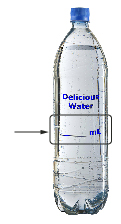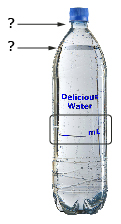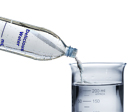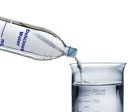Lesson 1
1. Lesson 1
1.4. Discover
Module 7: Volume and Capacity
Discover
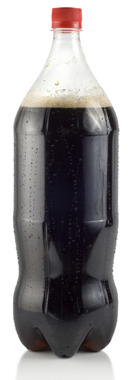
iStockphoto/Thinkstock
When you buy a bottle of juice or a soft drink, the packaging states the number of millilitres, or fluid ounces, in the container. What is this number referring to? Is it the amount of liquid in the bottle when you purchase the bottle, or is it the maximum amount of liquid the bottle can hold if filled to the very top? Would you use the term volume or capacity to describe this number?
You are going to investigate the difference between the terms volume and capacity using an unopened bottle of juice, water, or soft drink.
Try This 1
Step 1
iStockphoto/Thinkstock |
Look at the packaging of an unopened bottle of juice, soft drink, or water. In the first blank cell of the first row of a table like the one that follows, write the number of millilitres or fluid ounces written on the package.
|
Step 2
iStockphoto/Thinkstock |
Is this number the amount of liquid in the bottle, or is this the maximum amount the bottle can hold? In the second row of the table, put a checkmark in either the second-last cell or the last cell. |
Step 3
|
Does the number stated on the packaging relate to volume or capacity? In the second row of the table, write your response in the cell below your checkmark. |
Step 4
water bottle: iStockphoto/Thinkstock; beaker: Hemera/Thinkstock |
Open the bottle and empty the contents into a graduated cylinder (best choice), beaker, or measuring cup. Record the number of millilitres or fluid ounces of liquid in the bottle in the table’s first row. |
Step 5
iStockphoto/Thinkstock |
Fill the bottle to the very top with water. |
Step 6
water bottle: iStockphoto/Thinkstock; beaker: Hemera/Thinkstock |
Empty your graduated cylinder, beaker, or measuring cup, and then pour the water from your bottle into the graduated cylinder, beaker, or measuring cup (the same one as used before). In the first row of the table, record the maximum number of millilitres or fluid ounces it took to fill the bottle. |
| Number Stated on the Package | Amount of Liquid in the Bottle | Maximum Amount of Water the Bottle Can Hold | |
| Amount in Millilitres or Fluid Ounces | |||
| Prediction: Volume or Capacity? | |||
| Volume or Capacity? |
Based on your results, answer the following questions.
- Was the bottle filled right to the top before you opened it? Does it make any difference what was in the bottle? Carbonated versus non-carbonated? If not, can you think of any reasons why the bottle was not filled to the top?
- Compare the amount stated on the packaging to the amount of liquid originally in the bottle and the maximum amount of liquid the bottle can hold. Are any of these numbers equal or close to equal?
-
Look up the definitions for volume and capacity. You can read the definitions in the multimedia pieces provided: Volume, and Capacity. In the bottom row of the table, label each of the three columns as either volume or capacity.
- Define the terms volume and capacity in your own words. Provide an example of each word based upon what you learned in Try This 1.
![]() Save your responses in your course folder.
Save your responses in your course folder.
